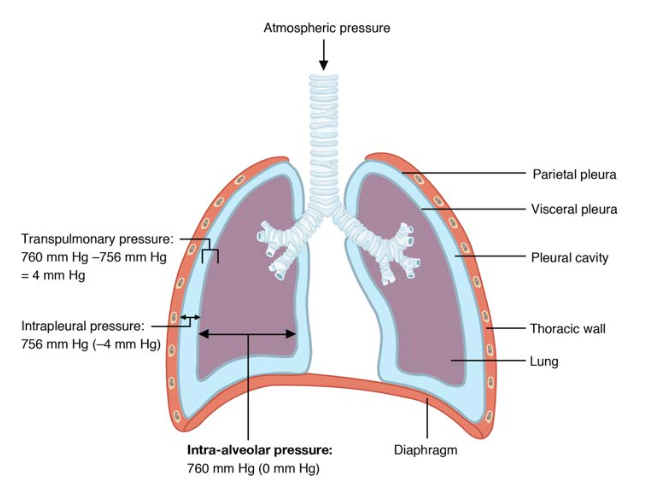Describe the Process of Pulmonary Ventilation
A respiratory cycle is one sequence of inspiration and expiration. Pulmonary ventilation comprises two major steps.

The Process Of Breathing Anatomy And Physiology Ii
Solution for Describe the process of pulmonary ventilation.

. Pulmonary ventilation commonly known as breathing is the process of moving air into and out of the lungs. Inspiration when the air moves into the lungs and expiration when the air leaves the lungs. The connection between a gass pressure P and volume V is described by Boyles Law.
As air moves into and out of the lungs it travels from regions of high air pressure to regions of low air pressure. Start your trial now. The process of respiration involves four stages ventilation which we know as breathing inhalation or inspiration and exhalation or expiration exchange of gases between the air in the lungs and blood stream pulmonary diffusion transport of gases in the blood perfusion and exchange of gases between the blood and tissues peripheral.
Air flows from a region with higher pressure to a region with lower pressure. First week only 499. What is pulmonary ventilation.
Pulmonary ventilation provides air to the alveoli for this gas exchange process. Ventilation is the mechanical movement of gas or air into and out of the lungs. Breathing Process of moving air into and out of the lungs to change and refresh gas in the lungs.
It is a mechanical process that depends. Gas exchange occurs in the lungs between alveolar air and the blood of the pulmonary capillaries. Air moves into lungs when pressure inside lungs is less than atmospheric pressure air moves out of lungs when pressure inside lungs is greater than atmospheric pressure.
Breathing or pulmonary ventilation has two phases - inspiration or inhalation and expiration or exhalation. It involves two events. Air flows due to pressure differences between the atmosphere and the gases inside the lungs.
Moving air into and out of the lungs. Respiration is Gas Exchange. In the medical world breathing is defined as pulmonary ventilation described as the movement of air between the atmosphere and the lung alveoli.
Respiration consists of 4 distinct processes. Flow of air leaving lungs. PV constant or P 1V 1 P 2V 2 are common View the full answer.
Respiration is the exchange of CO2 for oxygen. 11 rows Pulmonary ventilation is the act of breathing which can be described as the movement of air. Pulmonary ventilation is commonly referred to as breathing.
Ventilation V refers to the flow of air into and out of the alveoli while perfusion Q refers to the flow of blood to alveolar capillaries. Alveoli receive air from. For effective gas exchange to occur alveoli must be ventilated and perfused.
Weve got the study and writing resources you need for your assignments. According to the law if the volume rises the pressure must decrease or vice versa. Ventilation often is misnamed respiration.
At the respiratory membrane where the alveolar and capillary walls meet gases move across the membranes with oxygen entering the bloodstream and carbon dioxide exiting. Circulation refers to actual blood flow and oxygen delivery. Pulmonary ventilation or breathing is the exchange of air between the atmosphere and the lungs.
It moves through the pharynx larynx and trachea into the lungs. Inspiration is the process that causes air to enter the lungs and expiration is the process that causes air to leave the lungs Figure. The respiratory system aids in breathing also called pulmonary ventilation.
Respiration refers to the exchange of gases between a living organism and its environment while breathing is the process that moves air into and out of the lungs Thibodeau and Patton 2005. Pulmonary ventilation is the process of air flowing into the lungs during inspiration inhalation and out of the lungs during expiration exhalation. It is the process of air flowing into the lungs during inspiration inhalation and out of the lungs during expiration exhalation.
Diffusion of gases between the blood of the systemic capillaries. Flow of air into lungs. Transport of oxygen and carbon dioxide between the lungs and tissues.
Air flows because of pressure differences between the atmosphere and the gases inside the lungs. 1 Pulmonary ventilation is also known as breathing. The purpose of the respiratory system is to perform gas exchange.
Anatomy of the lungs Air enters the respiratory system through the mouth and the nasal cavity passing through the pharynx then larynx where sounds are produced for speech and finally the trachea which enters the chest cavity. In pulmonary ventilation air is inhaled through the nasal and oral cavities the nose and mouth. Pulmonary ventilation is mostly known as breathing it is the process whereby air flows into the lungs during inspiration and outside of the lungs during expiration.
Air flows because of pressure differences between the atmosphere and the gases inside the lungs. Process of exchanging gas O2 and CO2 between blood and alveoli. Air goes in and out of the lungs during breathing.
While pulmonary ventilation is the process by which oxygen enters and carbon dioxide exits the alveoli respiration is the process by which oxygen and carbon dioxide.

Respiratory System Karen Lancour Patty Palmietto Ppt Video Online Download


Comments
Post a Comment